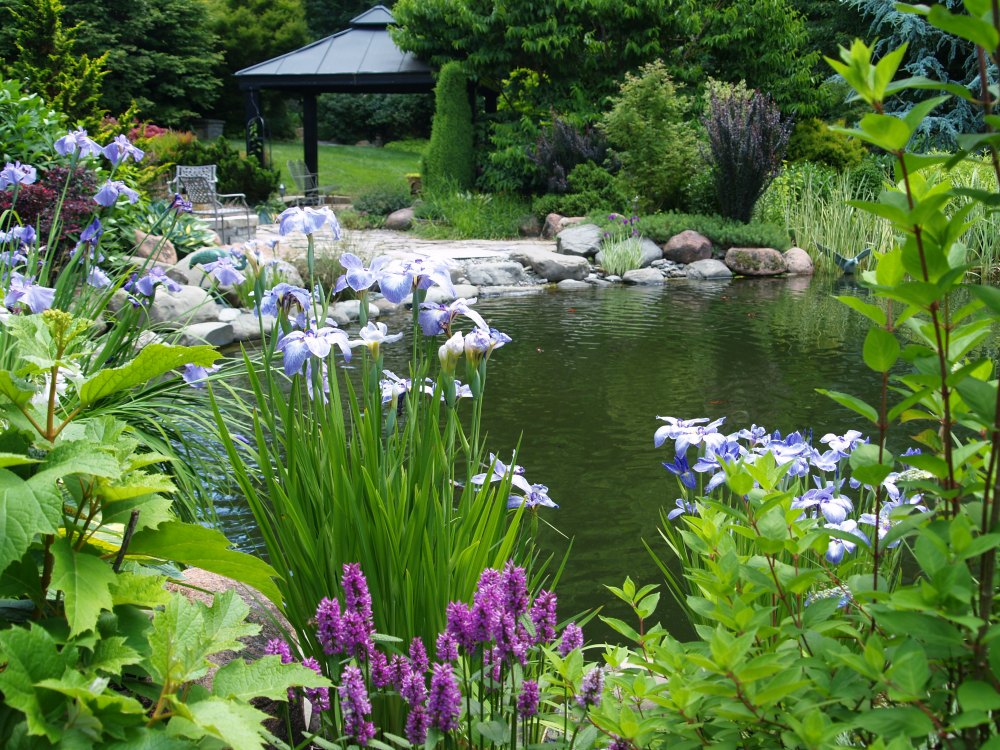Finally, ice on the large koi pond is receding. The pond’s pump was left running through the winter, so there has been at least a spot of open water, which has varied in size through the winter’s temperature fluctuations. Through the coldest parts of winter the pond was almost entirely frozen, with a hole only a foot or two across.

After the recent three week stretch when temperatures edged above above freezing only a time or two, there were tracks from more than one sort of beast in the snow across the ice. I imagined one of the local herd of deer crashing through as it ventured across the ice for a drink. How could it be rescued, and if the rescue failed, what then? Fortunately, such a dreadful thing did not occur, and after a few days in the fifties the ice is now nearly gone.

In the next few weeks the cattails, sweetflags, and irises in the pond must be cut back to remove the slimy, spent foliage, but there will be little other maintenance to this large pond. A few of the garden’s five ponds might be emptied to clean the accumulated clutter from the past year, but there is no doubt that the koi pond will not be pumped dry.
This pond contains at least twenty thousand, and maybe twenty five thousand gallons of water by my quick calculations. When it was constructed, it was mostly filled by two tropical storms that September, and I’ve little doubt that two back to back storms are unlikely to occur any time soon. Certainly, I will not be paying for water to fill the pond, ever.

A net covers a portion of the pond beginning sometime in mid autumn to catch most of the leaves that would float in on breezes from the neighboring forest, and before the irises and sweetflags can be cut back, the net must be dragged off. Both putting the net on, and taking it off are chores best suited for more than just me, but that’s all there is, and certainly I would not dream of asking my wife for assistance. After the fact she wonders why I manage this task without asking her help, but be assured that no matter how awkward, this sloppy job is best accomplished without her.
Each year I am anxious to see the koi and goldfish on the first warm afternoons when they surface to beg for food, so the net will be gone by the weekend if the weather cooperates. There is no concern that fish might perish over the winter, though in a few winters I’ve turned the pump off and the pond was frozen for a bit longer than I should have allowed. This year, midway through January the pond was mostly clear of ice for a few days, and I spotted several koi slowly swimming along the bottom of the pond. After the net is removed it will not be long before the koi swim at the surface to enjoy the sun warmed water.
Dave…still enjoying all your posts. Hoping you’ll see this. I was surprised to see that the harsh temperatures here in N. Va have turned about half the leaves of our large nandina forest a light to dark brown. Should we expect this brown to be replaced by green in the spring, or are these bushes doomed?
Until a few weeks ago when temperatures dropped below zero for a few days, I thought we might escape this winter with the nandinas remaining evergreen. But no, foliage has turned brown over the past few weeks. There is just about zero doubt that the nandinas will be completely fine. The current foliage will drop, and new growth will fill in completely, but the new growth is usually not evident until mid April. I have many nandina cultivars, and all are pretty well evergreen until temperatures drop below zero. I don’t think any could possibly be killed by our worst winters.
Thanks for the comforting words. These were transplants over the years from the Atlanta area so I worried that they were offspring from warmer weather plants. They are the gigantic, wild nandinas, and generally do not die in spite of abuse I may send their way. AND, the deer don’t eat them. All around, a very good almost-evergreen bush for us.